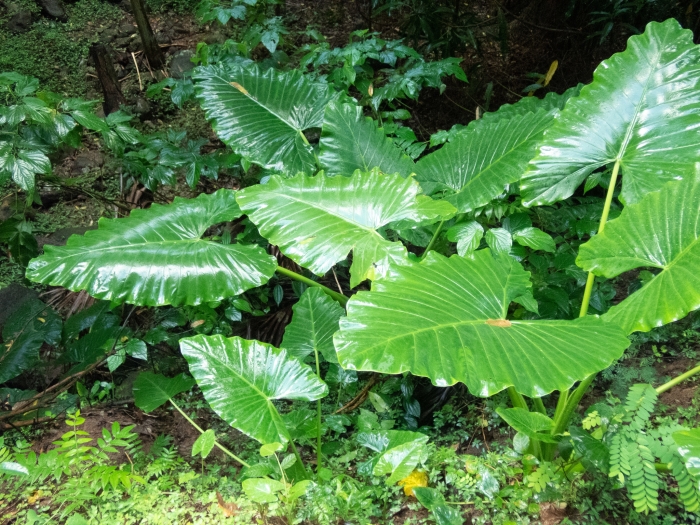Giant Taro
(Alocasia macrorrhizos)
Giant Taro (Alocasia macrorrhizos)
/
/

Don Loarie
CC BY 4.0
Image By:
Don Loarie
Recorded By:
Copyright:
CC BY 4.0
Copyright Notice:
Photo by: Don Loarie | License Type: CC BY 4.0 | License URL: http://creativecommons.org/licenses/by/4.0/ | Rights Holder: Don Loarie | Publisher: iNaturalist | Date Created: 2020-01-13T09:09:59-08:00 |
























Estimated Native Range
Summary
Alocasia macrorrhizos, commonly known as Giant Taro or Giant Alocasia, is a perennial herb native to the understory of tropical rainforests in Maritime Southeast Asia, New Guinea, and Queensland. It has also been widely cultivated in South Asia and the Pacific Islands. This plant can reach up to 15 feet (4.5 meters) in height and 8 feet (2.4 meters) in width, with large, glossy, heart-shaped leaves that can grow up to 6 feet (1.8 meters) long on sturdy, succulent stems. The leaves are a deep green color and can create a dramatic tropical effect in the garden. Giant Taro blooms with a yellow to white spathe and spadix, but the flowers are not particularly showy compared to the foliage. It does not typically produce notable berries or fruit.
Giant Taro is valued for its bold foliage and architectural form, making it a striking feature in tropical-themed gardens, as a specimen plant, or in large containers. It is also grown for its edible corms and leaves, which are an important food source in Pacific Island cultures. In cultivation, it requires consistently moist soil, high humidity, and partial to full shade conditions to mimic its native rainforest habitat. While it can be a beautiful addition to the right environment, it is potentially invasive in some regions and can outcompete native vegetation. Gardeners should check local regulations before planting and manage its spread responsibly.CC BY-SA 4.0
Giant Taro is valued for its bold foliage and architectural form, making it a striking feature in tropical-themed gardens, as a specimen plant, or in large containers. It is also grown for its edible corms and leaves, which are an important food source in Pacific Island cultures. In cultivation, it requires consistently moist soil, high humidity, and partial to full shade conditions to mimic its native rainforest habitat. While it can be a beautiful addition to the right environment, it is potentially invasive in some regions and can outcompete native vegetation. Gardeners should check local regulations before planting and manage its spread responsibly.CC BY-SA 4.0
Plant Description
- Plant Type: Herb, Bulb
- Height: 6-12 feet
- Width: 5-10 feet
- Growth Rate: Rapid
- Flower Color: Green, White
- Flowering Season: Spring, Summer
- Leaf Retention: Evergreen
Growth Requirements
- Sun: Full Sun, Part Shade, Full Shade
- Water: Medium
- Drainage: Medium
Common Uses
Border Plant, Potted Plant, Water Garden
Natural Habitat
Understory of tropical rainforests in Maritime Southeast Asia, New Guinea, and Queensland
Other Names
Common Names: Upright Elephant Ear, Ape, Cunjevoi, Giant Alocasia, Inhame-Açú, Malanga, Elephant Ear, Mankachu
Scientific Names: , Alocasia macrorrhizos, Alocasia cordifolia, Alocasia gigas, Alocasia gigas, Alocasia grandis, Alocasia harrisii-pulchrum, Alocasia indica subsp. diversifolia, Alocasia indica subsp. heterophylla, Alocasia indica subsp. metallica
GBIF Accepted Name: